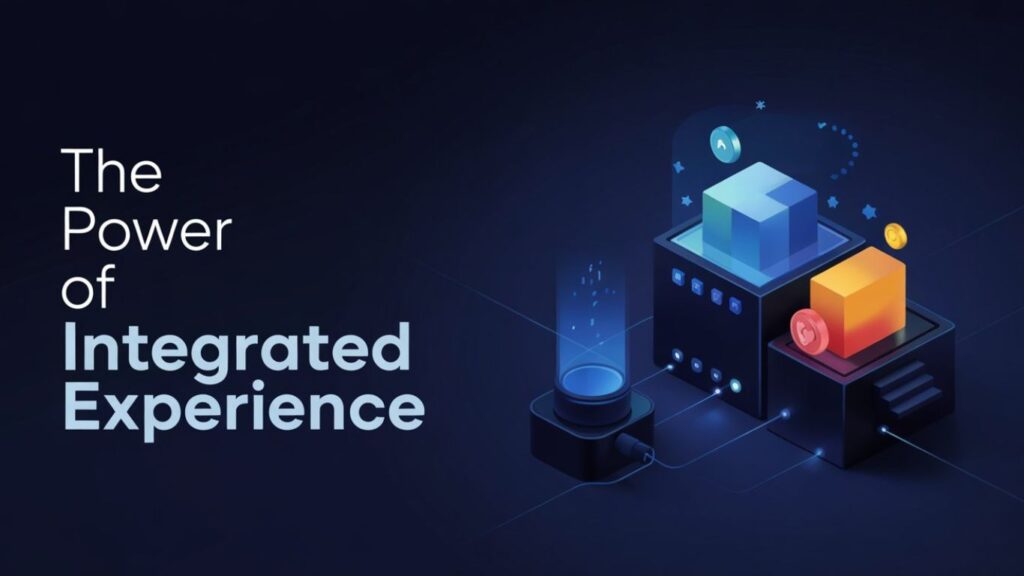The Power of Integrated Experience: What Does Integrated Experience Mean?

In today’s fast-paced and competitive business landscape, companies are increasingly focusing on providing seamless and cohesive interactions for their customers, employees, and stakeholders. But what does what does integrated experience mean truly mean, and why is it becoming a game-changer for businesses across the globe?
In simple terms, integrated experience refers to a strategic approach where multiple touchpoints, services, and platforms work in harmony to provide a unified, consistent, and personalized experience for customers. This approach not only enhances customer satisfaction but also drives operational efficiency and business growth.
In this article, we’ll delve deeper into what integrated experience means, why it’s important, and how businesses can build and optimize it for long-term success.
What Does Integrated Experience Mean?

An integrated experience is all about creating a seamless journey for customers across various channels. Whether they interact with a company online, through a mobile app, in-store, or via customer support, the experience remains consistent and uninterrupted.
An effective integrated experience ensures that users don’t have to repeat themselves or face disjointed service as they move from one platform to another. It’s a holistic approach to customer experience, where the boundaries between different service channels disappear, providing customers with a smooth, frictionless, and highly personalized journey.
Key Components of an Integrated Experience
Understanding the building blocks of an integrated experience is crucial for businesses aiming to deliver this strategy successfully. Let’s break down the key components:
Consistency Across Channels
Customers expect a unified brand experience no matter where or how they interact with a company. This means that branding, messaging, and service quality must remain consistent across websites, mobile apps, social media, physical stores, and customer support touchpoints. Whether customers are shopping online or visiting a physical store, they should feel that they are dealing with the same company, delivering a familiar, high-quality experience.
Personalization and Customization
Personalization has become one of the most essential aspects of an integrated experience. By leveraging customer data, businesses can customize their services and communications to suit individual preferences. Personalized experiences are known to significantly improve customer satisfaction, as they make customers feel valued and understood. This can range from tailored product recommendations to personalized email campaigns or even custom website content based on past interactions.
Seamless Technology Integration
The technological infrastructure behind an integrated experience is crucial. It involves connecting CRM systems, AI-powered chatbots, automated workflows, cloud-based solutions, and other platforms to create an interconnected ecosystem. When systems work in harmony, businesses can automate processes, deliver faster service, and keep all customer touchpoints synchronized, making the customer journey smoother and more efficient.
Cross-Department Collaboration
An integrated experience is not just about technology; it’s about people working together across departments. Collaboration between sales, customer service, marketing, and other departments is essential to ensure a consistent customer journey. For example, if a customer contacts customer service regarding a previous interaction, the representative should have access to the customer’s history, making their response faster and more informed.
Real-Time Data Utilization
Real-time data is a key element of an integrated experience. By analyzing customer interactions as they happen, businesses can predict future needs, optimize services, and improve the customer journey in real-time. For instance, if a customer is experiencing an issue on the website, real-time data can alert the company’s team to intervene before the customer abandons the purchase.
Why Is an Integrated Experience Important?
Now that we understand what an integrated experience means, let’s explore why it is essential for modern businesses.
Enhances Customer Satisfaction
The primary goal of an integrated experience is to make things easier for the customer. Customers prefer a smooth journey across various touchpoints—whether they are browsing a website, chatting with a support agent, or walking into a physical store. An integrated experience ensures that their inquiries, purchases, and interactions remain consistent, leading to higher satisfaction. Customers who are satisfied with their experience are more likely to return and recommend the company to others.
Boosts Brand Loyalty and Retention
A well-executed integrated experience fosters trust and loyalty. When customers receive personalized, seamless, and consistent interactions, they form a stronger bond with the brand. This encourages repeat business, as customers are more likely to return to a company that consistently meets their needs. Furthermore, happy customers are more likely to recommend the brand to others, enhancing its reputation and broadening its customer base.
Increases Operational Efficiency
Operational efficiency is another significant benefit of an integrated experience. By connecting various platforms and automating tasks, businesses can eliminate redundancies, reduce human error, and enhance the speed of customer service. For instance, integrating a CRM system with an email marketing platform can streamline communication, ensuring that marketing campaigns reach the right customers without requiring manual intervention.
Provides a Competitive Advantage
In today’s crowded market, offering a seamless and personalized experience gives businesses a significant edge over competitors. A strong integrated experience sets a company apart, as customers are more likely to choose businesses that offer a unified journey. This can be especially crucial in industries where customers have a wide variety of choices.
Drives Higher Revenue and Growth
Businesses that prioritize customer experience are more likely to see higher sales and increased customer lifetime value. A seamless experience often leads to higher conversion rates, repeat purchases, and even customer referrals. When a company delivers exceptional service, customers feel more comfortable spending money and returning in the future.
Real-World Examples of Integrated Experience

To illustrate what an integrated experience looks like in practice, let’s examine some leading companies that have successfully implemented this strategy:
Apple
Apple is a prime example of a company that has built an integrated ecosystem of products and services. Whether customers are using an iPhone, iPad, MacBook, or Apple Watch, the experience remains seamless thanks to cloud synchronization and cross-device compatibility. From purchasing on the Apple website to using the Apple Store app or interacting with Apple support, customers enjoy a unified and consistent journey across multiple touchpoints.
Amazon
Amazon takes integration to the next level by connecting its website, mobile app, voice assistant (Alexa), and customer support systems. This ensures that customers can effortlessly switch between platforms while receiving the same high-quality service. Whether a customer is shopping on the website or ordering via voice command through Alexa, the experience remains uninterrupted and cohesive.
Starbucks
Starbucks uses its mobile app, in-store ordering system, and rewards program to create a connected customer experience. Customers can place an order through the app, earn rewards, and pay via their phone, making the entire process more efficient and personalized. Additionally, the app integrates with the Starbucks loyalty program, offering discounts and rewards based on customer preferences.
Disney
Disney provides an outstanding example of an integrated experience through its theme parks and resorts. Using tools like MagicBands and the Disney World app, visitors can check into their hotel, access rides, and make payments without needing to carry cash or tickets. The experience is carefully designed to ensure convenience and personalization for every guest, enhancing their time at the parks.
Challenges of Implementing an Integrated Experience
While the benefits of an integrated experience are clear, there are also significant challenges that companies must address in order to achieve success.
Technology Barriers
Legacy systems and outdated technology can hinder smooth integration between various platforms. It may require significant investment in new systems or even a complete overhaul to ensure seamless communication between channels.
Data Privacy and Security Concerns
Handling customer data requires strict security measures. As businesses collect more data to personalize experiences, it’s essential to ensure that sensitive information is protected from breaches or misuse. This is particularly important as data privacy regulations continue to evolve.
High Implementation Costs
Developing and maintaining an integrated experience can be costly. From purchasing software and infrastructure to training employees and continuously optimizing services, businesses must be prepared for ongoing investment. However, the long-term benefits of increased customer satisfaction and operational efficiency often outweigh the initial costs.
Organizational Resistance
Resistance to change is a common challenge when implementing new strategies. Employees and departments accustomed to working in silos may be reluctant to collaborate across functions. Overcoming this resistance requires strong leadership and effective change management.
How Businesses Can Build an Effective Integrated Experience

Building an effective integrated experience requires strategic planning and the right tools. Below are steps businesses can take to create a seamless and personalized customer journey:
Develop a Unified Digital Strategy
To create a cohesive experience, businesses must align their digital strategy across all touchpoints. This ensures that customers encounter consistent messaging, branding, and service quality whether they’re interacting online, in-store, or via customer support.
Leverage AI and Automation
Artificial Intelligence (AI) and automation can help streamline processes, enhance personalization, and predict customer needs. By implementing chatbots, automated email campaigns, and AI-powered recommendation engines, businesses can improve efficiency and customer satisfaction.
Focus on Customer-Centric Approaches
Understanding customer pain points and expectations is key to delivering a seamless experience. Regularly gather customer feedback, monitor behavior, and adapt services based on their needs.
Train Employees for Cross-Functional Collaboration
Cross-departmental collaboration is critical for an integrated experience. Training employees to share information and work together across departments helps eliminate silos and ensures that all customer touchpoints are aligned.
Continuously Optimize Based on Data Insights
Analyzing customer data is essential for continuous improvement. Track performance metrics, assess feedback, and optimize processes based on insights gathered from customer interactions.
Frequently Asked Questions (FAQs)
1. What does integrated experience mean in business?
An integrated experience refers to a strategy where multiple customer touchpoints (such as online platforms, mobile apps, and in-store interactions) work together to create a seamless, unified experience.
2. How does an integrated experience benefit customers?
An integrated experience ensures that customers receive a consistent and personalized service, improving satisfaction and increasing loyalty.
3. What industries benefit the most from an integrated experience?
Industries such as retail, technology, healthcare, finance, and hospitality benefit significantly from providing an integrated experience.
4. How can small businesses implement an integrated experience?
Small businesses can start by using CRM software, integrating social media, and automating customer service tools to create a more cohesive experience.
5. What role does AI play in creating an integrated experience?
AI helps businesses automate processes, personalize interactions, and analyze customer behavior, contributing to a more efficient and tailored customer experience.
Conclusion
So, what does integrated experience mean in today’s business landscape? It’s a strategic approach that ensures customers enjoy a seamless, consistent, and personalized experience across various platforms and touchpoints. By focusing on consistency, personalization, and real-time data, businesses can improve customer satisfaction, loyalty, and operational efficiency.
While implementing an integrated experience can be challenging, businesses that invest in the right technology and focus on customer-centric strategies will be well-positioned for success. As the business world becomes more competitive, delivering a truly integrated experience is no longer a luxury—it’s a necessity for sustained growth and success.
CLICK FOR MORE INFORMATION Dailynewsbizz.com




